Wednesday, 27 June 2018
Update and Moving On
Friday, 10 July 2009
Crochet Ball "necklace"
There are pictures of my ball necklaces here on my main blog.
What I did was
Round 1) Ch4, join to make a ring and work 6dc into the centre - join by making a sl st into the first dc
Round 2) (Increase round) Work 2dc into each dc - join
Round 3) Dc into each dc of previous round. Join
Round 4) (Decrease) Work dc2tog all round. Join
Leave a tail and fasten off.
Turn it inside out and stuff it with leftover yarn to make it as hard or soft as you want and use the tail to close the end.
In fact after a while I changed step 1 and instead of the initial crochet chain I started with a “loop” ring which can be pulled completely closed. Debbie Stoller in "The Happy Hooker" calls this the “adjustable” or magic ring method and the best I can do is to refer you to her excellent description.
My smaller beads I made with 4 or 5 dc into the ring and the larger ones with 6-8dc. Then I threaded them onto ribbon with knots between each.
PS I have used UK crochet abbreviations - I know the US ones are different.
Friday, 20 March 2009
TopDown Raglan Shaped Round Neck -Regia
This was knitted in Regia Bamboo colour 1064 Ethno on 3.25mm needles, tension about 7 sts/1"
I cast on 102 sts onto one circular needle magic looped.
Stocking st for 6/7 rounds,to make the neck roll, then 3 rows k2,p2 rib - to stop it rolling anymore.
I placed 2 stitch markers together to mark the beginning of the round - the centre back then
k18, PM,K1,PM
K10, PM,K1,PM
Wrap the next stitch, Turn and work back (ie purl) to the centre back and continue
P18,PM,P1,PM
P10,PM,P1,PM
Wrap next stitch
Transfer the stitches left for the front plus the two wrapped stitches onto a spare dpn or short circular.
Continue working in st st increasing one stitch before and after each seam marker and at the end of esch row work the wrapped stitch and wrap the next stitch from the front stitches.
Thats the end of my notes.....I must have thought the rest was obvious....
I'm going to make another similar jumper next week so I'll add to this.
Wednesday, 19 March 2008
TopDownRaglan WIP
This is a record of my attempt to make a top-down raglan with the exact fit and neck-line that I want. Therefore it will be subject to random editing and additions until I'm happy with it.
I haven't been able to find a pattern that was exactly what I wanted. The closest I found was this from Sarah but no pattern.
I used Barbara Walker's book "Knitting from the Top", Pamela Costello's "Incredible Custom-fit Raglan Sweater" from Woolworks and modified Stephanie Japel's "Raglan from the top down" and I've arrived at what I hope will be just what I wanted.
My result so far-
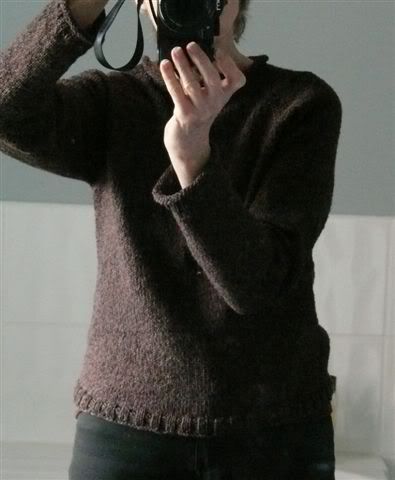
What I did:
9 x 50gm balls of Rowan Classic Yarns Luxury Cotton DK Shade #257 - Char
Knit Picks Options 3.75mm(US 5) and Addi Turbo 4mm for the sleeves because by then my gauge had changed.
Gauge (yes, I checked it) 22sts = 4"
Cast on 80 sts.
Join to knit in the round, place marker at centre back for beginning of round and knit about 9 rounds of stocking stitch and on last round place sleeve markers like this:
k15, pm, k1, pm, k8, pm, k1, pm, k30, pm, k1, pm, k8, pm, k1, pm, k15. All the k1 stitches are "seam" stitches.
Now start the raglan increases by increasing before and after each seam stitch.
As the knitting grows you'll be able to try it on and when it meets under your arms you're ready to separate the sleeves. It measured 9"from the "neckband" (measured along a raglan seam) and the front section had increased to 92 stitches.Work the next round and slip the sleeve stitches onto spare yarn when you come to them and continue working in rounds until it's long enough. Then a bit of 2x2 rib and the front and back are done.
Knit sleeves, decreasing every 4th or 5th round - I followed the shape of an existing sweater and I finished with 5 rounds of 2 x 2 rib and then 6 rounds of st st so that it would roll like the neck.
What I've learned from this:
1. I think it needs to be a bit longer.....I can fix this easily enough....And there's a picture with the longer length on the other blog.
2. The neck should be smaller - quite a lot. Although I measured it, in wear it seems to stretch. I've sort of fixed this by working some back stitching at the bottom of the neck roll. This has tightened it up and it fits better.
3. I think the neck line would be improved if I did two rows of rib and then some short-rowing after the neck roll so that the front would curve down like a smile.
4. The raglan length might need to be adjusted.
5. Should I divide the stitches so that less are on the sleeve sections? I don't know yet.
So those are thoughts for the next top....and I want a lighter weight one. I'm swatching with Regia Bamboo. It's a sock yarn but I think it's just what I want.
Saturday, 2 June 2007
PatternOutline for Toe-Up Socks
I'd no idea how hard it would prove to be to write down what I knit so easily so if you find any mistakes, please tell me.
You need to read it in conjunction with the various references and explanations!!
Pattern Outline for Toe-Up Socks.
I use one 80cm circular needle and cast on 12 sts using the Turkish Cast On. After working 2 rounds straight I work two rounds increasing at each end of the needles (16sts on each needle)- Make One leaning to Right at beginning of row and Make one leaning to Left at end of row. Continue the increases on alternate rounds to 30 sts on each needle - or as required for your foot. I always increase after the first st at the beginning of the row and just before the last stitch at the end.
Start working in your pattern on the top of the foot and stocking stitch on the sole.
I start my heel shaping about 2 1/2" from the back of my heel (try it on). About 4 rows before I shape the heel I increase at each end of the needle on alternate rows on the sole side only to give me 4 extra stitches to work the heel. It makes the heel slightly deeper and for me gives a better fit.
The heels are worked flat in rows of stocking stitch back and forward on the sole stitches only, decreasing with short row shaping down to 12 "live" stitches. Then start the short row increases to incorporate all the stiches again. I have described my no-wrap short rows in great detail and with pictures here.
Continue working in rounds, decreasing those extra 4 stitches over the next 2 alternate rows on the sole side. And now you can start patterning all round the sock.
Work in pattern until the required length and then work a rib. My preferred rib is 2x2 and I use one size larger needle because I don't like it at all tight.
Cast off loosely. I use the lace cast off where you work 2 stitches in pattern, slip them back to the LH needle and knit them together in back.* Work next stitch in pattern, slip these 2 sts back and knit together. Continue from * to end.
Variations
As an alternative to the Turkish Cast On I use a Provisional Crochet Cast On and knit 4 rows stocking stitch before picking up the stitches on the chain.
And the method that was my favorite until a few weeks ago is to work the toe as a short row toe.
To do this you start with an Invisible Cast On or Provisional Crochet Cast On and cast on half the number of stitches you need for your sock. For me that is 60 stitches so I cast on 30. Start knitting the short row toe in exactly the same way as the heel and when you are ready to start knitting in the round you just pick up the stitches on the spare circular or waste yarn. I have described this in detail and with pictures here.
Description of Terms
Turkish Cast On
This is described beautifully by Fluffy Knitter here.
Invisible Cast On
I love Priscilla Gibson-Roberts' method and description for the invisible cast-on in"Simple Socks" p46 or you can follow these instructions
Provisional Crochet Cast On
I follow Lucy Neatby's instructions for this in "Cool Socks Warm Feet" p110 or instructions here with a video
Make Ones Leaning to Left or Right are described in Priscilla Gibson-Roberts "Simple Socks" book p 58
Make One Leaning to Left:
Lift bar (between last stitch worked and next stitch) with the right needle and place it on the left needle so that the RH edge of this loop is at the front of the LH needle and knit it through the back. This makes a twisted stitch and therefore no hole.
Make One Leaning to Right:
Lift bar (between last stitch worked and next stitch) onto the left needle so that the RH edge of this loop is at the back of the needle and knit into the front, making a twisted stitch and no hole.
Short Row No-Wrap
My short row no wraps are based on Montse Stanley's method for Mitred Corners in her Knitter's Handbook p103. And it is almost the same as "Knit Encroachment " and "Purl Encroachment " described here
This is what I do:
Short row decreases:
Slip first stitch, work to the stitch before the end or the stitch before the marker. Don't wrap, just turn. Place a marker on the RH needle. Slip first stitch, work to one stitch before the marker. Turn. Place marker on RH needle. Continue like this working one stitch less each time until there are 10 - 12 stitches between the markers and begin short row increases.
Short row increases:
*Slip the first stitch, work to stitch before the marker, slip this stitch to the RH needle, discard the marker and put the slipped stitch back to the LH needle and work it together with the head of the stitch below the next stitch (knit together through the back on knit rows and just purl together on purl rows). Turn. Repeat from * until all the markers have been discarded and continue knitting in the round.
I have described this in minute detail with lots of pictures here. And a complete sock is described here - you can leave the lace out completely or put a pattern of your own in if you don't want the lace.
For more help consult Lauri B's Toes and Heels page .
Edited to add missing abbreviation section.
Wednesday, 21 March 2007
Flowering Desert Bloom
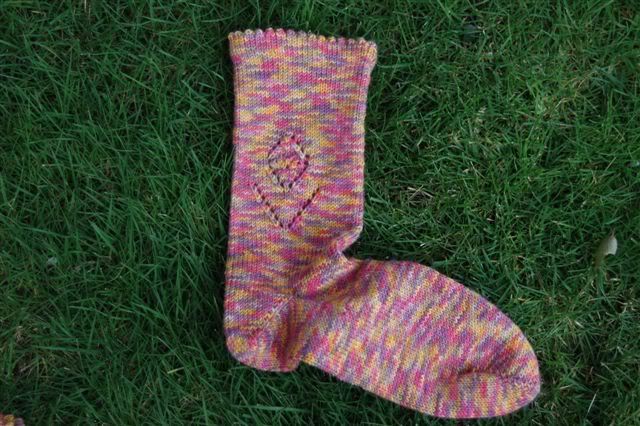
And here is a close-up of the flower motif.
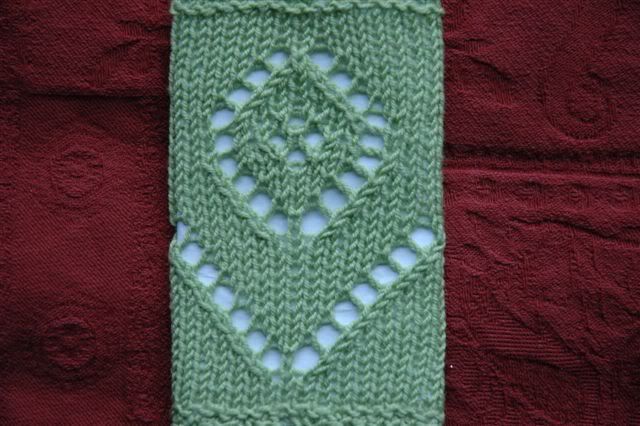 And the chart....
And the chart....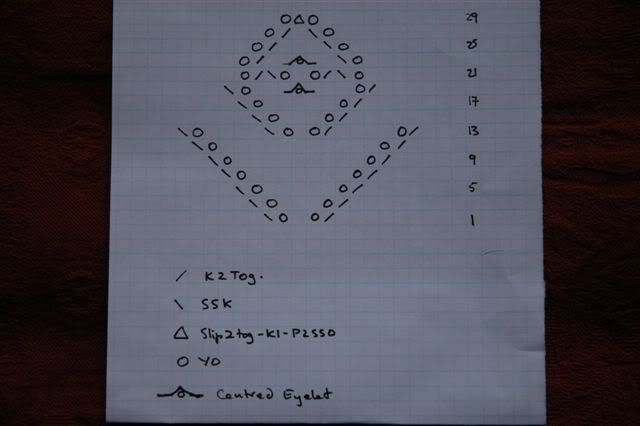 The sock itself follows my usual sock pattern - toe-up short row as described in Toe-Up lacy sock.
The sock itself follows my usual sock pattern - toe-up short row as described in Toe-Up lacy sock.
Kiss Cross Sock
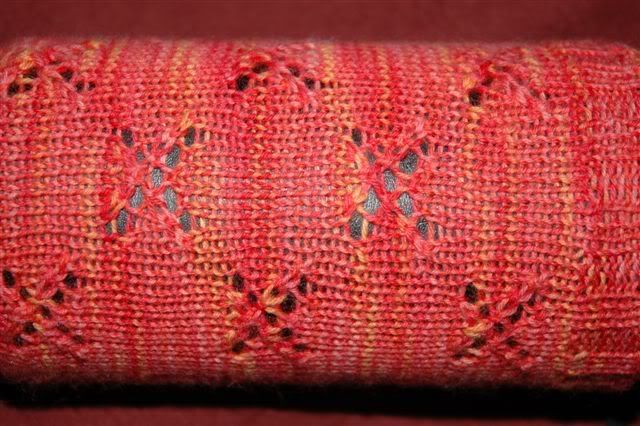
This is the lace chart- "XP7"- worked over 7 stitches and 10 rows
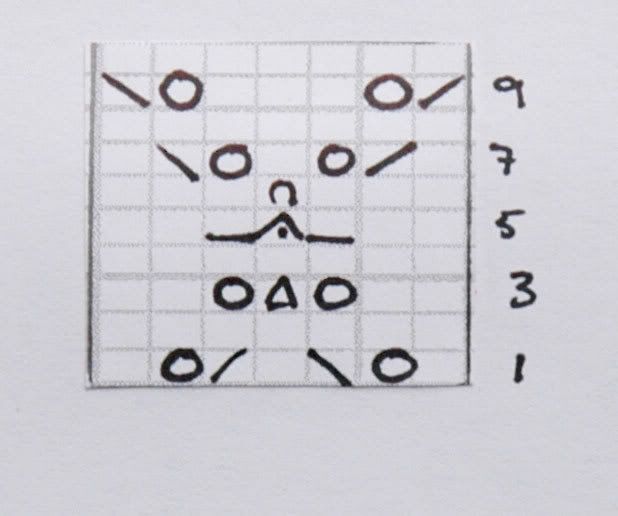
with the standard abbreviations
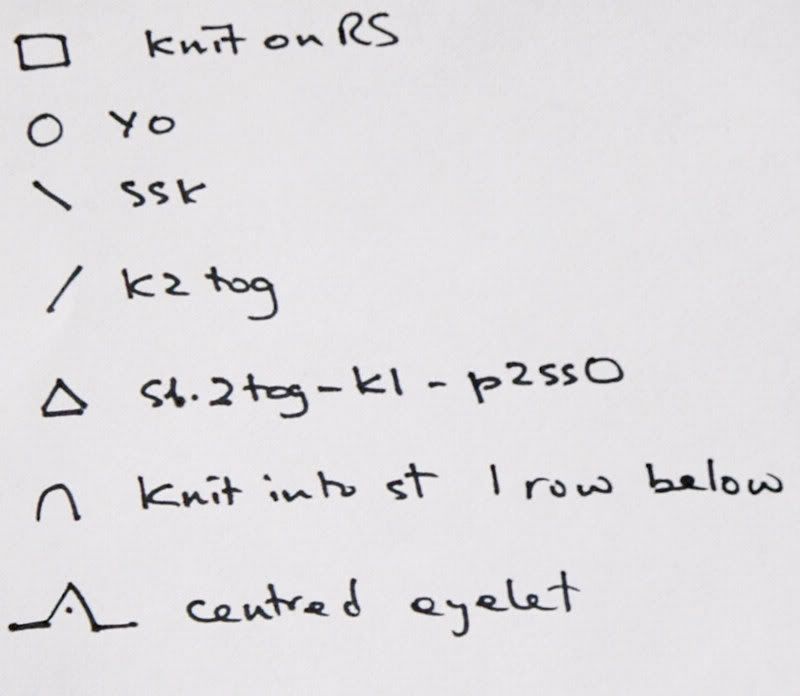
except for the Amy Detjen's centred eyelet which I first saw in "A Gathering of Lace" by Meg Swanson. All the blank squares are knit because you are working in the round with the exception of the next row stitch immediately above the centred eyelet - for this stitch you knit into the actual hole of the row below.
Amy's Centred Eyelet
This is worked over three stitches and leaves three stitches.
Slip the first stitch knitwise, begin to knit the next stitch but don't slip it off the LH needle. Pass the slipped stitch over the partial knit, Yarn Over, Knit 2 together (the remains of the partial knit stitch and the 3rd stitch). This completes the centred eyelet.
On the next row the stitch above this eyelet hole is knitted into the row below.
ETA On re-reading this I felt it needed a little clarification. These two links will help.
(Scroll half-way down in this first one)
http://www.schoolhousepress.com/kalpansyshawl.htm
and for a wonderful "deconstruction"
http://mathomhouse.typepad.com/bluestocking/2005/10/deconstructing_.html
Sock Notes
I used yarn from the YarnYard on Addi Turbos 2.5mm, 80cm with 60 stitches. The sock construction is exactly the same as my lace socks in the previous post.
Starting toe-up, after completing the toe part I arranged the stitches so that I had 28 sts on top and 32 underneath then I started the pattern for the top like this:
k4, XP7, k7, XP7, k3 and the underneath completely plain. Work the 10 rows of the chart followed by 4 rounds stocking stitch then:
k11, XP7, k10. Work the 10 chart rows and then another 4 rounds plain. Continue like this until its time to work the heel. Adjust the sts after the heel so that you have 56 stitches in total.
You do the leg in the same way except you need the pattern on both halves so you just continue the [k4, XP7, *k7, XP7 repeat from* to last 3 stitches, k3 ] pattern all round with 4 rounds straight after the chart rows. Now the only slight complication is that to avoid having the XP7 pattern at the beginning or end of the needles I just moved 3 stitches from the end of each needle to the beginning of the next.. It's obvious when you come to it BUT put a marker so that you know where the round starts then you continue with the XP7 pattern making sure the crosses are worked above the seven knit stitches to make the criss-cross pattern.
This sounds really complicated but I think it's my poor descriptive technique because it wasn't hard at all.
Please if you find any errors, let me know. I feel thoroughly confused myself now.